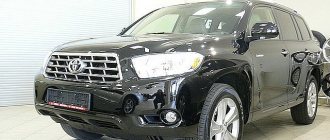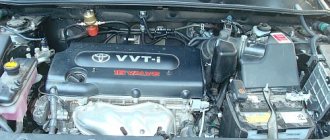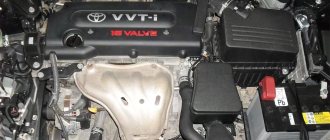In the early 2000s, the Japanese automaker Toyota seriously decided to thoroughly gain a foothold in the new car market in our country. At the time of the release of the Camry Behemoth (body version with the index V30), the line of models was not particularly popular among car enthusiasts of both new and used cars (applies mostly to the Far East). However, the first photos of the new product gave consumers hope that the situation could change dramatically, and this eventually happened.
Model technical data
Among the technical innovations of the body, it is worth noting new and modernized engines (the line of engines was presented for our market in 3 copies). The lowest-power 2.0-liter engine did not gain much popularity among car enthusiasts or the approval of repairmen due to the imperfections of some important components and assemblies, the difficulty of repair and its high cost. Consumers were not satisfied with the mediocre dynamics and long gear shifts in conjunction with an automatic transmission.
Other versions of engines with a volume of 2.4 and 3.0 liters were in great demand, as they were relatively reliable in operation, inexpensive to maintain, and also had an excellent service life (they could last about 400,000 kilometers without major repairs).
The suspension and driving characteristics of the car have also undergone changes. Starting with this body, the model acquired a legendary smooth ride, indifference to joints and holes, all thanks to the long-term adjustment of the independent suspension and the innovations introduced in comparison with previous versions of the body (which is clearly visible in the comparison photo).
When driving, the car held the road confidently and took turns without critical rolls (which is already an excellent result for a one and a half ton car).
This model passed the safety tests quite successfully, receiving the highest score (which was confirmed by photo and video recording). As practice has shown, the model is still very popular to this day due to the high overall reliability of almost all units and components (which is confirmed by numerous photos).
Reviews:
Dmitry Sirotkin, driving for 12 years, driving a Toyota Camry for 4 years
I bought myself a 2007 Toyota Camry four years ago. The previous owner said that the car was torn from the heart. Today I understand him better than ever. I drive a lot, sometimes up to 12 hours, especially in the summer. Fatigue after such trips is only moral. You don’t get tired physically at all, and, most likely, this is because of the comfortable seats. I read reviews of other owners about the 2007 Toyota Camry, who say that it is like a cow, and I completely disagree with them. I sometimes take turns at speeds of 150 km/h.
Andrey Rotaenko, 9 years of experience, driving a Toyota Camry for 2 years
I've been driving a Camry for several years now. I currently have a 2008 Toyota Camry. with 2.4 l engine. Before that there was a V40, and it was she who created the first impression of the Japanese. Camry is indestructible: I came to the service only for the maintenance. The suspension is soft and elastic. I often traveled out of town on broken roads. I've always been pleased with the size of the trunk. I play hockey and I have a very large bag with my uniform. However, it fits into my car with a whiz, although my teammates told me that the 2008 Camry did not turn out very well for Asians. But I don't agree with him.
German Kiselev, driving experience for 8 years, driving a Toyota Camry for 6 years
6 years of driving pleasure. I'm in love with this car and don't want to give it to anyone. A very worthwhile specimen. I have a Toyota Camry 2009. I bought it new and during this time I have driven almost 250 thousand km. All I did was change the pads, oil, filters, discs and once the front shock absorbers. Due to the large size of the car, the maximum speed in strong crosswinds is 120 km/h.
Stepan Rybnikov, driving for 11 years, driving a Toyota Camry for 5 years
I've been driving for a long time and I understand that only the Japanese can be trusted. The Germans are angry, oil-hungry and capricious. For my Toyota Camry, 2006 was the beginning of life. Then my father bought it. He gave it to me five years ago, but just as she listened great then, she continues to hold her own. Only consumables changed. Once there was something knocking in the automatic transmission, but then it stopped and did not occur again.
Maxim Morozov, driving for 13 years, driving a Toyota Camry for 4 years
It’s funny, but I chose my Toyota Camry based on a photo, and specifically the 2006 model, because experienced Camry drivers told me that this is the most successful version. Perhaps it’s a little old for today, but, oddly enough, it works like a charm for me. When I bought it, I changed the suspension a little and the pads and discs. I especially like the AT, which runs very smoothly. I have nothing to compare with, but, for example, according to some reviews from owners, the same 2008 Toyota Camry suffers from a sluggish transmission. Whether this has changed since 2006, I don’t know. I only know that AT’s “thoughtfulness” doesn’t bother me at all.
General exterior and interior design
In the production of this model, the company's engineers and designers relied on large smooth lines and stampings along the entire perimeter of the body. This trend is fully consistent with the spirit of the time and design trends. The car turned out to be quite impressive even within its class. At the same time, in terms of comfort, big changes occurred with the introduction of this body. Inside, the cabin received large wood-look inserts on the front panel (in previous versions they were used infrequently), as well as the side doors of the cards were trimmed with soft material. It is also worth noting that the materials of the front panel and doors (plastic) at that time met the highest standards, and the build quality was considered one of the best (which is clearly visible in the photo of the interior).
With an increase in the wheelbase, the space inside the cabin has accordingly increased, and this has had a greater impact on the rear passengers.
The back row can easily accommodate three passengers with a relatively high level of comfort.
Also a distinctive feature of the new model is a huge trunk with a capacity of more than 500 liters (it is possible to fold the rear row backrests in a 2/3 ratio).
Suzuki
Suzuki sells few models here. The purebred Japanese Grand Vitara left the market with the onset of the crisis; its place was taken by the compact crossover Vitara, which is now imported from Hungary. The former Russian bestseller SX4 also has European assembly. It is also manufactured in Hungary.
The only car that comes to us from Japan by ship halfway around the world is the Jimny subcompact SUV.
First Camry – V10 1982 – 1986
The history of Toyota Camry began in the early 80s of the 20th century. The very first model, the V10, was developed for the Japanese domestic market. Subsequently, the car was actively sold on the foreign market, from 1982 to 1986.
The ancestor of the first body is considered to be the Toyota Celica Camry sports sedan (1980-1982). But the Camry's wheelbase was increased by one hundred millimeters, which made it possible to achieve more space in the cabin. In addition, the developers decided to move the fuel tank under the rear seat. This led to a significant increase in luggage space.
The location of the engine in the engine compartment has changed. Now it was located transversely. There were 3 types of gasoline engines installed on the cars:
- 1.8 1S-U 100 hp;
- 2.0 2S-ELU 120 horses;
- 2.0 3S-GELU 160 horsepower.
Diesel engines were also installed:
- 1.8 1C-TL 80 hp;
- 2C-TL 88 horsepower.
All engines were equipped with a 5-speed manual transmission or a 4-speed automatic transmission.
Where is the VIN code on Camry?
To ensure that buying a car second hand does not bring additional hassle, it is important to check the vehicle identification code indicated in the title and the labels with the VIN. They are located on the vehicle. The VIN code for Toyota Camry 40 is located in three places:
- Upper left corner of the dashboard. If you look closely at the front of the car, you can see the place where the plate with the code is located.
- Under the front right passenger seat. To do this, you will need to carefully examine the interior of the vehicle.
- On the body rack. The code label can only be seen when the right passenger door is open.
On the instrument panel and under the seat you can find the VIN code itself, and on the body pillar there is a plate where, in addition to the VIN, the motorist can also find out the paint number of the vehicle.
Important! The VIN codes placed on the car must be identical to each other. Otherwise, you should refuse to purchase such a vehicle.
To check the VIN, you should contact the traffic police department and ask an employee to check the VIN of the vehicle. This is necessary in order to make sure that the Toyota Camry is not listed as stolen and is not pledged to the bank. Many drivers perform the check themselves.
To do this, the vehicle's VIN code must be entered on the website of the State Road Safety Inspectorate. In addition, on the Internet you can find many free sites that will provide a decoding of the car’s VIN code according to the main parameters. On paid Internet resources, the driver can obtain the most complete information on deciphering the VIN of his vehicle.
Toyota Camry models from 1990 to 2000
From 1991 to 1998, there were several Toyota Camry models in parallel. Small-sized models V30 and V40 were produced for the Japanese market. And the American buyer was offered larger cars, the XV10 and XV20, with a modified design.
V30 body for Japan
The 3rd generation of the legendary Japanese sedan was produced from 1990 to 1994. This body is notable for the new options that have appeared. The most expensive trim levels included a driver airbag and ABS. Also in the expensive Camry V30, the developers installed rear wheel steering (4WS). At the same time, there was a significant price gap between the basic and top configurations.
Different engines were available for the V30:
- 1.8 petrol 4S-FE 115 hp;
- petrol 2.0 3S-FE 135 (140) horses;
- 2.0 petrol 3S-GE 165 horsepower.
A turbocharged diesel engine, 2C-T, was also installed, producing 91 horsepower.
As before, buyers had access to all-wheel drive and two transmissions: 5 manual transmission and 4 automatic transmission. The automatic transmission could operate in winter and sports mode.
The V30 model was restyled in the summer of 1992. After it, the GT package was replaced by a touring package. The list of options for this option included original R15 alloy wheels, a spoiler, foglights, a leather steering wheel, and two-way steering wheel adjustment.
Model Toyota Camry V40
The creation of the fourth generation Toyota Camry was accompanied by a serious economic crisis in the land of the rising sun. In this regard, the developers focused on the practicality of all V40 trim levels.
The power plants of the V40 generation were inherited from the previous V30 model (petrol 1.8 4S-FE, 2.0 3S-FE). Only the diesel engine has changed; instead of the 2.0 2C-T, a 2.2 3C-T (with a power of 90 hp) was installed.
Independent, MacPherson-type spring suspension was installed front and rear. Improved four-wheel maneuverability of the Camry V40 was achieved through the use of the 4WS system.
The 1996 V40 update affected the optics; they became more modern. Also available in the middle trim levels: wood trim, airbags, ABS, remote control key and leather steering wheel.
Body for America XV10 1991 - 1996
Camry, designated XV10, appeared in the United States in 1991 and was sold in three body styles: sedan, station wagon and coupe. The wheelbase of the car was increased to 2620 mm, the length of the body was 4725 mm, and the width was 1770 mm.
The American version of the XV10 was equipped only with gasoline engines: 2.2 5S-FE 125 (130) hp, 3.0 3VZ-FE 185 horses, and after an update in 1994 - 3.0 1MZ-FE 188 horsepower. There were 2 gearboxes - 5 manual transmission and 4 automatic transmission.
Standard safety features included a driver's airbag, front seat belts with load limiters, adjustable head restraints, and anti-lock and traction control systems. For an additional fee, the XV10 was equipped with cruise control and an airbag for the front passenger.
XV20 – the fifth generation of the Japanese sedan
The XV20 model appeared in 1996, replacing the first Camry XV10 wide body. But in Japan, the XV 20 was called the Toyota Camry Gracia until 1998, because at the same time a “narrow” version of the V40 was produced.
In the fifth generation cars, the interior design was completely changed. The interior used high-quality plastic with wooden inserts. The instrument panel was harmoniously combined with the interior. The level of sound insulation in the cabin was not satisfactory. A comfortable position behind the wheel has been designed for the driver. The steering column and lumbar support were adjustable.
The gasoline engines used in the fifth generation Camry sedan were made in two variations: four-cylinder 2.2 5S-FE with a power of 140 hp. and V6 2.5 2MZ-FE, producing 200 horses. This body, like the XV10, did not offer diesel engines. But in the Japanese market, the XV20 retained all-wheel drive in some trim levels.
The V6 2.5 2MZ-FE petrol engine was not offered on the global market for the fifth generation XV20. Instead, the cars were equipped with an older internal combustion engine - V6 3.0 1MZ-FE (194 hp). Also available to buyers was a four-cylinder 2.2 5S-FE with 131 hp.
Build quality in Russia
Experts note that the quality of the Russian assembly of the Toyota Camry model is inferior to the identical Japanese assembly model. This is reflected in the following differences:
- Japanese assemblers equip the car with Yocohama tires, and Russian assemblers use Michlen;
- when performing paint and varnish work at a plant in Russia, materials of lower quality are used;
- When installing glass elements, Russian-made products are used. It is also inferior in quality to Japanese glass.
At the same time, the power unit and many other important structural elements for the Toyota Camry are delivered to Russia assembled. The delivery is carried out by foreign partner companies of Toyota Motor.
Passenger seats are manufactured directly in the production shops of the Russian enterprise. Their quality fully corresponds to the level of chairs from Japanese manufacturers, while the design is completely identical.
In general, the build quality of the Russian company is comparable to Japanese models. This is due to strict adherence to the technological process. All individual production operations are carried out in accordance with the instructions. They are the same for all factories. Cars are subject to specialized quality control, which allows them to maintain the required reliability and quality. If significant defects are detected, the machine is sent for recycling. Camry characteristics such as dynamics, handling, interior equipment and noise insulation are at the same level as cars assembled in Japan.
Toyota Camry sixth generation – XV30 2001 – 2006
This body has significantly increased in size (almost 7 cm in height, the wheelbase has increased by 5 cm). This happened because the main market for Camry was North America, and there the client loves big cars. The XV30 generation was sold between 2001 and 2006.
In the US and Canada, buyers of the XV30 were offered three petrol engines. Among them are 2.4 2AZ-FE 157 hp, 3.0 V6 1MZ-FE 192 (210 horsepower after update) and another V6 3.3 3MZ-FE (225 hp). In America, manual and automatic transmissions were available with the XV30, but there were no all-wheel drive trims.
Camry XV50 – the eighth body
Production of the Toyota XV50 began in 2011. Subsequently, the developers made minor amendments to the body. Restyling (2014) of the XV50 body did not bring significant changes, but completely changed the appearance of the car. At the same time, the Camry XV50 had a different appearance depending on the region of production and sale.
The XV50 hybrid engine model was not offered on the Russian market, but three gasoline engines were offered:
- the least powerful 2.0 1AZ-FE was equipped with a 4-speed automatic transmission;
- 2.5 2AR-FE 181 hp
- 3.5 2GR-FE.
The medium and large engines were coupled with a 6-speed automatic transmission.
In the domestic Japanese market, the eighth generation Camry was offered only in a hybrid version. Moreover, a new gasoline internal combustion engine was installed in tandem with an electric motor. Its volume is 2.5 2AR-FXE.
In the States, the XV50 body had three powertrain options. The hybrid version of the car is driven by a pair - an electric motor and an internal combustion engine 2.5 2AR-FXE. Also exclusively petrol engine options were available: 2.5 2AR-FE with a unit power of 178 horses and 3.5 2GR-FE - 268 hp.
Second generation (1986-1991)
The new model was a success among car enthusiasts (especially on the American continent) and four years later a new generation was released in sedan and station wagon bodies. The updated version has increased in size, and its exterior and electronics have undergone some changes. Improved materials were used to decorate the interior. The modernization also affected technical characteristics:
- Engine: petrol 1.8, 2 or 2.5 liters, diesel 2 liters
- Transmission: manual / automatic
- Maximum speed: from 165 (1.8 l, auto) to 210 km/h (2.5 l, manual)
- Acceleration: 9.5 s (2 l, gasoline, manual) -14.4 s (2 l, diesel, automatic)
- Average fuel consumption per 100 km: 8 liters (2 liters, diesel, auto) – 11 liters (2.5 liters, petrol, auto)
Toyota Camry 2nd generation
Camry salon 2nd generation
Ninth Toyota Camry body – XV70
The new XV70 body appeared in 2021. In this generation, engineers designed a single car for all markets, abandoning the development of different designs for the United States, Japan and eastern Europe. In Russia, the new body began to be produced much later than in Japan and the USA. Three gasoline engines are available on the Russian market:
- 2.0 6AR-FSE 150 hp;
- 2.5 2AR-FE 181 hp;
- 3.5 2GR-FKS 249 hp
In America, as in the previous body, there are three engine options:
Technically, the engines have been greatly improved, which is visible to the naked eye when comparing power indicators with previous power plants. Also in the USA and Canada, the XV70 model is sold with an 8-speed automatic transmission.
The new Toyota Camry 70 body has become longer and wider compared to the previous generation. The created design gave the car an expressive appearance.
Differences from other versions
The 2007 Toyota Camry differs from the 2000 generation primarily in appearance. The body received more convex parts, became a little longer and acquired streamlined features. The rear of the car is no longer sharply beveled, but has the same pleasant rounded shape as the front.
Unlike cars of the 2000s, the 2010 Toyota Camry had narrower and elongated front and rear lights, a more aggressive grille with elegantly curved horizontal lines that seemed to bend under the emblem, and a respectable interior.








